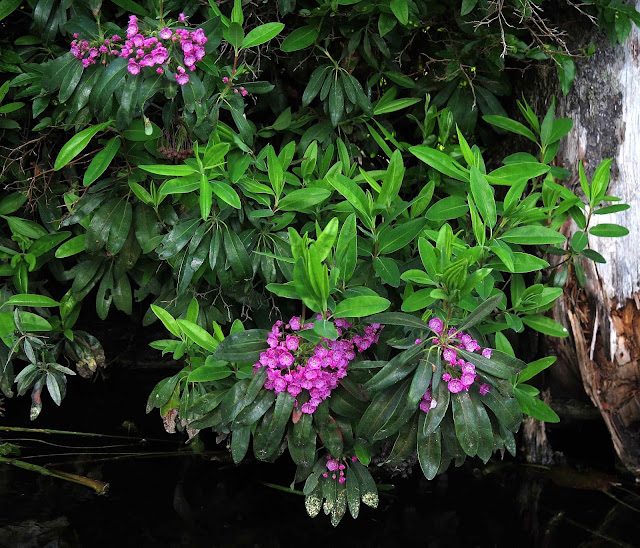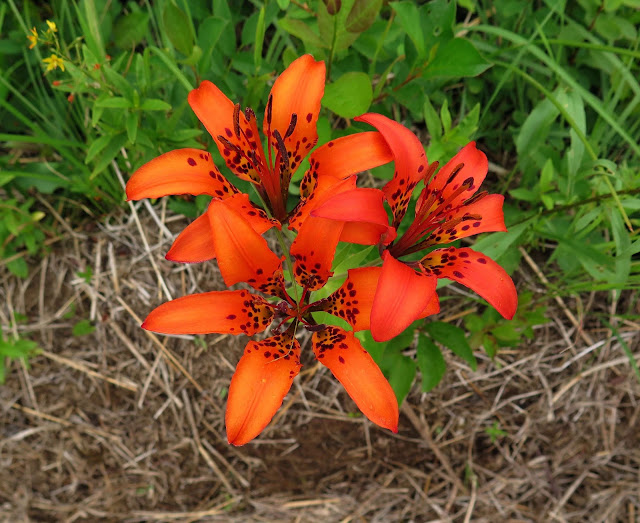Household tasks were calling to me, and I fully intended to stay home today to tend to them. But I always look at my Facebook page each morning, hoping to see my darling grandkids smiling at me from photos their parents posted. But today, it was ORCHids, not grandkids, whose photos I found in my Facebook Memories, along with this alert: two native orchids should be blooming now along the Hudson River. OK, chores can wait. I could spare an hour or two for just a brief paddle to see if I could find those orchids again.
So here I am, setting off on the river, in search of those two orchids: Shining Ladies' Tresses (Spiranthes lucida) along the banks, and Tubercled Orchid (Platanthera flava) out on one of the islands.
In other years, I always have found my first sought-after orchid, the Shining Ladies' Tresses, growing very close to the water along the shore. So that's where I was moseying when I saw this odd collection of tiny green jelly-like orbs cohering into floating shapes like hunks of miniature corn cob or six-parted posies.
What the heck IS this stuff?! I have seen floating green jelly-like orbs of a cyanobacterium called Nostoc balls, but they don't stick together like this, nor do they show up until the fall. Also, I could pick those up and they kept their perfectly round shape in my hand. As soon as I touched these shapes, they disintegrated into amorphous slime. The only way I could bring them closer to examine them was to hold water in my hand. Then I could see that each orb was made up of tinier transparent orbs. Anyone want to bet these are the eggs of some aquatic critter?

UPDATE: Turns out, these floating greenish blobs are the frass of Spongy Moths, which were eating the leaves of the the trees hanging over the water. Pieces of the chewed-on leaves can be seen floating near the frass blobs. I found it hard to believe this, thinking the blobs were way too big to have passed out the anus of a small caterpillar. But when I googled "images of Spongy Moth feces" I found photos of that looked just like this. Amazing!
I was so fascinated by these globs I almost forgot about that Shining Ladies' Tresses orchid. But then I looked up, and there she was! On the bank, very close to the water. This is our earliest-blooming species of Spiranthes, and our only one with a bright-yellow lower lip. I found just one, but that's all I have ever found, right here in the very same spot. And some years, none at all. (Sigh! Orchids are like that!)
OK, let's go look for that other orchid now. So off I paddled, out to a series of small islands, not far from where I launched my canoe. It sure was a pretty day for a paddle. I could have stayed here all day.
Well, that other orchid, the Tubercled Orchid, was NOT where I used to find them. Not a single one, where once I found close to 30. The population has fluctuated over the years, but I never came away completely empty, as I seemed to be doing today. Oh well, this little island is full of other pretty flowers. Here's one called Small Sundrops (Oenothera perennis), of such a bright yellow they DO resemble small pieces of the sun dropped down to earth. I always have to turn the exposure way down on my camera, if I hope to capture any detail at all in the brilliant blooms.
And oh, the lovely Common Blue-eyed Grass (Sisyrinchium montanum) was winking its radiant blue eyes among the other low plants across the island. (Including LOTS of Poison Ivy. Lucky for me, I seem to have outgrown my adverse reaction to it.)
And here was one of my very favorite flowers, called Creeping Spearwort (Ranunculus flammula var. reptans), with individual blooms so teeny weeny it's very easy to miss it. At least, for now. Those curving stems will travel across the damp sand, rooting at nodes as they go, and eventually a vast carpet of them will cover the ground, starred with dozens of bright-yellow blooms. It's that very exuberance that endears this tiny flower to me.
So there I was, making my way around the edge of the island, when a fallen log too high to step over forced me to walk around it. And look what I found sheltering beside the log on the other side: a trio of Tubercled Orchids, just coming into bloom! Not the big population of some other years, but enough to relieve me that they have not vanished from this island completely. Oh, happy day!
The scientific name for this orchid, Platanthera flava, refers to its yellowish blooms (flava means "yellow" in Latin), but the vernacular name refers to the little bumps ("tubercles") that protrude from the lower lip of each floret. I think in this photo you can see that little bump on some of these florets.
Mission accomplished! I found both orchids! Guess it was time to get back to my household chores. But wait a minute! What's going on with the terminal pinnae of these Royal Ferns? I found almost every plant with terminal tips formed into globular balls and wrapped with webbing. Is some critter pupating in there? Or what? I thought I should take a look inside, and I peeled the pinnae back, one at a time.
Aw jeez, what the heck is this gunky looking stuff? It sure doesn't look like eggs or even a pile of pupae to me! Could that be a caterpillar lurking there above the pile? (I didn't notice it until I enlarged this photo.) Could that possibly be a huge pile of frass some larva has excreted? Whoever heard of a caterpillar piling up its poop and wrapping it with web?
UPDATE: I took one of the fern-tip chambers home and opened it, and found inside this tiny larva that sure doesn't look big enough to have pooped out that huge pile of frass. Maybe the larva that produced that frass was an older, bigger one.
As soon as I got home, I posted these photos on various sites, hoping some insect expert will get right back to me. If so, I will get right back here and tell the rest of this story.
UPDATE: A friend named Mary Esch has sent me a link to a post describing a very similar pupation chamber formed by a moth caterpillar from fern pinnae, where the moth eats the fern tissue and defecates into a pile until it pupates. The moth described in that post, though, eats ONLY the pinnae of Sensitive Fern, and mine were forming their pupation chambers from the pinnae of Royal Fern. I bet the moths are at least related, if not the same. Here's a link to that blog post discussing the moth in question:
https://naturerambling.blogspot.com/2014/05/fern-ball-mystery.html





















































